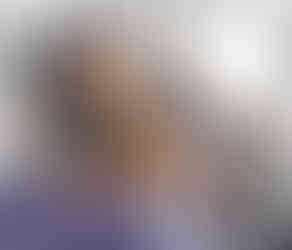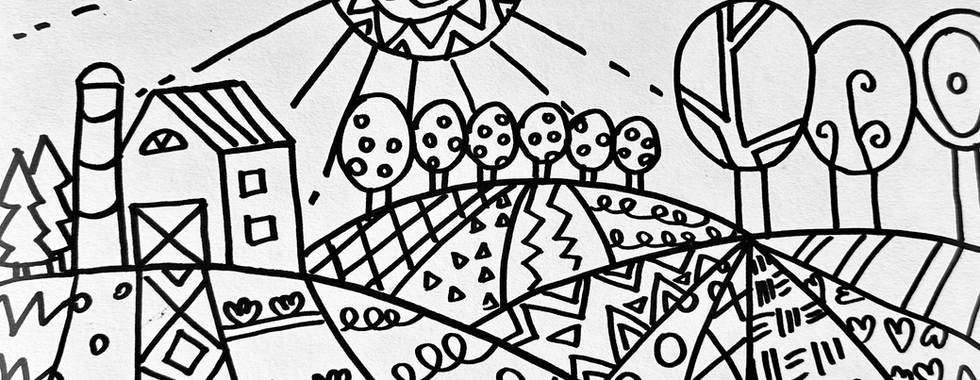Folk Art Farm Landscapes
- Emily Gould
- Sep 2, 2023
- 4 min read
Updated: Oct 5, 2023

Today we will create artwork in the style of Heather Galler. We will find inspiration from Heather’s Farm Landscape series and create our own colorful farm landscape using many exciting patterns.

What time of day do you want to paint?
Sunrise, sunset, afternoon or night?
What season will you paint?
Who Is Heather Galler?


A PATTERN is a design that repeats and can be found anywhere. They can be made by repeating shape, line, or color. Patterns can be simple like a checkerboard or complex like the branches of a tree. Heather Galler's artwork is filled with patterns of lines, shapes, and colors.

Let's get started....It might be best to first start drawing with a pencil. Draw light until you get it right. When you have established your composition use a Sharpie to go over your pencil lines.
This art lesson uses basic art supplies and will take at least two art classes to complete.

Download your copy of Farm Landscape Drawing Idea Guide here
The Folk Art Farm Landscape art lesson is on video!

Encourage students to draw different barn styles. I highly recommend the book, Farm Anatomy: The Curious Parts and Pieces of Country Life by Julia Rothman You can find the book on Amazon. Every time I teach a lesson about farms I use this book! This book is an incredible visual reference to life on the farm. You will find this illustration of Common Barn Styles and many more. This book inspires my students and is an incredible resource for every Art Room.

Elementary students draw Folk Art Farm Landscapes. Here students are getting ready to add patterns to their compositions.

After adding color with crayons students paint over the crayon marks with watercolor paints and notice the watercolor paint does not stick to the wax in the crayon. This is called the "Crayon Resist Technique."


TIP. ..It really helped to have a visual display of the project steps. I had to remind students that there was not too much coloring with crayons, "We are only coloring in small shapes with the crayons!" Most of the color is from watercolor paint. Students enjoyed trying out the Crayon Resist Technique. Did anyone notice one of the pictures is out of order?
Slide Show of the Process
It's helpful to have a visual display of the process (in the proper order)
This slide show will help students to visualize the process of creating this Folk Art Farm Landscape.
1. Draw Farm Landscape outline with black Sharpie
2. Add Patterns with black Sharpie
3. Add color with crayons. Do not color in entire drawing just some of the shapes and/ or lines.
4. Paint over picture with watercolors
Another version of the process...I emphasize that the horizon line does not have to be a straight line!
What is a Horizon Line in Art?
The Horizon Line is the line as far as the eye can see. You have probably seen the Horizon Line last time you were at the ocean. From the beach look at the sea, that line where the sea ends OR looks like it ends. That's as far as the eye can see also known as the Horizon Line. Often the Horizon Line is that line in the composition that divides the sky and the land. When looking at the sea the Horizon Line is that line that divides the sky and the sea.
Can you find the Horizon Line in this composition?
How is the Horizon Line in this composition different from the other composition?
Questions to ask students:
How does this picture show the illusion of distance?
Objects further away are smaller. To create the illusion of distance in a work of art the artist changes the sizes of objects within the composition. The apple trees in the background are smaller than the Fall trees in the middle ground. The further away an object the smaller it gets. Objects closer to the horizon line are further away and therefore smaller. The closer an object is to the viewer the larger it is. Foreground is usually the bottom of the paper.
Help students to see Foreground, Middle Ground, and Back Ground to better understand the element of Depth.
Is the entire picture colored in crayons?
No, only some of the shapes are colored in crayons. Sometimes lines are outlined in crayons. Most of the color comes from the watercolor paints.
What is the process of using watercolor paint to paint over crayons called?
"The Crayon Resist Technique"
Can you still see the crayon lines under the watercolor paint?
Yes. You can especially see the white crayon now! It's hard to see white crayon on white paper but when you paint over the white crayon with watercolor paints it's like magic, the white crayon lines appear through the watercolor paints. For best results, press hard with your crayon marks so that you can get a lot of wax on your paper before applying watercolor paint over crayon lines. You may need to demo the Crayon Resist Technique because some students are not going to want to paint over the crayon fearing that the crayon marks will disappear. Do the demo with a white crayon, it's magical!
Why does the paint not cover over the crayons lines?
The wax from the crayons resists the watercolor paint. The crayon marks shine through the watercolor paint to create a layering effect that adds depth to the composition. For best results, press hard with your crayon marks so that you can get a lot of wax on your paper before applying watercolor paint over crayon lines.

Folk Art Farm Landscapes by Ms. Gould
Student Gallery

This art lesson was taught online, Zoom platform, to students ages 6-12 years. The online art lesson was one hour. As you can see one hour is not enough time to finish this art lesson. I recommend at least two art classes for this art lesson.

Sara, Grade 4

Wolf, Grade 4.

Amira, Grade 2

Neora, Grade 1

Tzvi, Grade 4

Arik, Grade 8

Eyal, Grade 8
Tag me on Instagram...I look forward to seeing what your students create!

































Comments